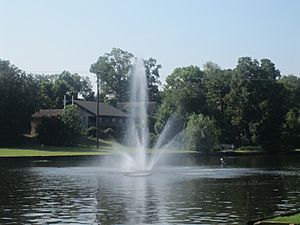Cane River facts for kids

The Cane River (also known as Rivière aux Cannes) is a river about 30 miles (48 kilometers) long in Natchitoches Parish, Louisiana. It was formed from a part of the Red River. The Cane River is famous for its rich history and culture, especially for the Creole de couleur people. This unique culture is centered around important places like the Melrose Plantation and St. Augustine Church.
Contents
What is the Cane River?
The Cane River is a special waterway in Louisiana. It used to be part of the much larger Red River. Over time, the Red River changed its path, leaving behind a section that became the Cane River. This river flows through Natchitoches Parish, which is a historic area in Louisiana.
How the River Formed
Long ago, the Red River was a major waterway in the region. It carried a lot of water and sediment. Over many years, the river naturally shifted its course. When the main flow of the Red River moved to a new channel, a part of its old path was left behind. This leftover section became the Cane River. It is now a slower-moving river, but it still connects to the Red River system.
Culture and Heritage Along the Cane River
The Cane River area is well-known for its unique history and culture. It is especially important to the Creole de couleur people. These are people of mixed European, African, and Native American heritage. Their culture has deep roots in this part of Louisiana.
The Creole de Couleur Community
The Creole de couleur community along the Cane River has a long and proud history. Many of these families have lived in the area for generations. They developed a distinct culture, language, and traditions. This community played a big role in shaping the history of Louisiana. They built churches, homes, and plantations that are still important today.
Important Historic Sites
Two of the most famous places along the Cane River are the Melrose Plantation and St. Augustine Church. These sites help tell the story of the Creole de couleur people.
Melrose Plantation
The Melrose Plantation is a National Historic Landmark. It was one of the first plantations in the United States owned by free people of color. The plantation shows how these communities lived and worked. It also highlights their contributions to farming and culture. Today, visitors can learn about the history of the people who lived there.
St. Augustine Church
St. Augustine Parish (Isle Brevelle) Church is another very important site. It is located in a community called Isle Brevelle. This church was built by the Creole de couleur community. It has served as a spiritual and social center for them for many years. The church is a symbol of their faith and strong community ties.
The Cane River Today
Today, the Cane River area is part of the Cane River National Heritage Area. This area works to protect and share the rich history and culture of the region. It helps people learn about the river, its natural beauty, and the diverse communities that have lived there for centuries. The Cane River continues to be a vital part of Louisiana's heritage.


